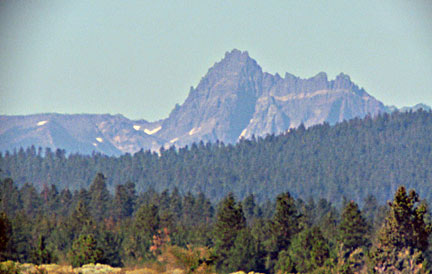 This
view was taken from the northeast, near Madras/Warm Springs. --
The image was achieved with a telephoto of about 4,000 mm effective
focual length...
This
view was taken from the northeast, near Madras/Warm Springs. --
The image was achieved with a telephoto of about 4,000 mm effective
focual length...Three-Fingered Jack Mountain, 7,844 ft.,
juts inconspicuously into its parcel of sky between Mt. Jefferson
and Mt. Washington. (click to go directly
to discussion of Wolverines).... The jagged peak is easy to
overlook from most of Oregon's major roads, and few common tourist
destinations have good views of it even though it is right on
the main Cascade Crest near a major mountain pass (the Santiam
Pass)......  This
view was taken from the northeast, near Madras/Warm Springs. --
The image was achieved with a telephoto of about 4,000 mm effective
focual length...
This
view was taken from the northeast, near Madras/Warm Springs. --
The image was achieved with a telephoto of about 4,000 mm effective
focual length...
The picture shows the dry pine forests of the Warm Springs Indian Reservation, north of Madras. A tiny residual glacier sits at the base of the main (left) rock face; it's unofficially named as "Jack Glacier." I've stood on its surface, and worried about rockfall from the very loose face far above.
Rock Climbs: Mountain Climbers know "Jack's" NE face
route to be one of Oregon's most treacherous and challenging rock
climbs, a grade III-5, first ascended in 1964 by B. Cummings and
Ted Davis. ... The peak's very first ascent was in 1923, by the
"regular" route up the south ridge. Even the regular
route is challenging and has lots of exposure, complicated by
the geological fact that unlike other heavily glaciated volcanic
peaks such as Mount Washington and Mount Thielsen,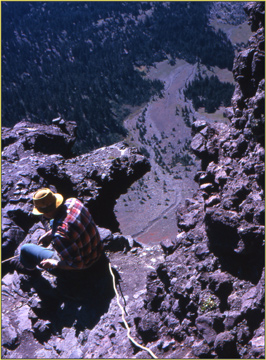 which display eroded volcanic necks as their cores, Three Fingered
Jack's present summit is only a narrow ridge of loose tephra supported
by a dike only 10 feet thick. It's definitely not confidence-inspiring.
When I climbed the final summit block, I was certain that when
I kicked it hard with my boot, I could feel faint vibrations,
like the entire block might just fall over and plummet itself
and me down the East Face.. The image of the climber is on the
normal climbing route, the South Ridge.
which display eroded volcanic necks as their cores, Three Fingered
Jack's present summit is only a narrow ridge of loose tephra supported
by a dike only 10 feet thick. It's definitely not confidence-inspiring.
When I climbed the final summit block, I was certain that when
I kicked it hard with my boot, I could feel faint vibrations,
like the entire block might just fall over and plummet itself
and me down the East Face.. The image of the climber is on the
normal climbing route, the South Ridge.
Back in 1965-66 at Oregon State University I was a beginning climber with the OSU Alpine Club. In various degrees, I knew some of these climbers who went on to distinguish themselves in Oregon climbing: the likes of Ted Davis, Ron Funke, Bob Bauman, Tom Bauman*, and John Marshall. Mostly, as it all turned out, I took pretty pictures from less precipitous locations while these great climbers were putting up first ascents in various locations in Oregon!...... (Back to image on page top)---At the foot of Jack's horrific-looking east Face lies one of Oregon's most idyllic mountain meadows, lovely Canyon Creek Meadows-- in the picture, it's at the foot of the immense rock wall with the tan band running across it.....
HISTORICAL-- the rather unique and colorful name of this Oregon peak derives from the outlaw Three Fingered Jack (real name was Tres Dedos). His life ended rather abruptly in 1853 when California Rangers killed both he and notorious Hispanic bandit Joaquin Muiretta in a raid on an outlaw camp in the Tulare Valley of California (Southern Sierras, near Sequia Tree National Monument)... The Rangers wanted to prove things to the Public, and so it was that Jack's famed hand was amputated, and joined the decapitated head of Murrieta in a big vat of whiskey that was transported to Stockton and other places in a gruesome public display.
One year after the first ascent of the
NE Face, "Jack" became famous in the annals of Oregon's
rare wildlife--- During the Fall of 1965 a hunter near the mountain
shot and killed a Wolverine, previously considered extinct in
Oregon since 1912 (see Oregon Department of Fish and Wildlife's
classic book "Oregon's Furbearing Mammals" (1979).....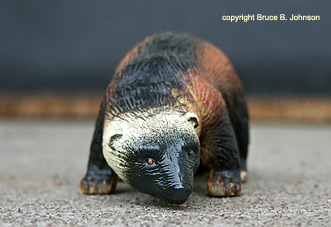 More recently reports
of wolverine sightings have come in from several locations in
Northeastern Oregon, including the Wallowas
and the Blue Mountains, and even Steens Mountain in the far southeastern
corner of the State has had a sighting... And an amazing "sighting"
took place on busy I-84 Freeway near Rowena, just west of The
Dalles, where crews picked up the squished remains of a wolverine,
in a hot lowland-type location far from any wilderness area (click for picture of the area)....
Other names for the very reclusive creature are "Glutton,"
"Skunk Bear" and "Carcajou." Males can weigh
as much as a medium-size dog, up to 50 to 60 pounds. They are
famed as the most ferocious mammal for their size in the World!
Even wolves, bobcats and grizzly bears give them wide berth.
More recently reports
of wolverine sightings have come in from several locations in
Northeastern Oregon, including the Wallowas
and the Blue Mountains, and even Steens Mountain in the far southeastern
corner of the State has had a sighting... And an amazing "sighting"
took place on busy I-84 Freeway near Rowena, just west of The
Dalles, where crews picked up the squished remains of a wolverine,
in a hot lowland-type location far from any wilderness area (click for picture of the area)....
Other names for the very reclusive creature are "Glutton,"
"Skunk Bear" and "Carcajou." Males can weigh
as much as a medium-size dog, up to 50 to 60 pounds. They are
famed as the most ferocious mammal for their size in the World!
Even wolves, bobcats and grizzly bears give them wide berth.
February 2006, WOLVERINE BREAKING NEWS!
Wildlife Biologists in the Northwest are thrilled. After a two
year hunt, they captured and radio-collared a live wolverine!
The story occurs in the remote Okanogan National Forest, which
lies on the eastern side of the Washington Cascades along the
Canadian border. Two years ago, from the air, they captured on
video a live wolverine running, evading them among 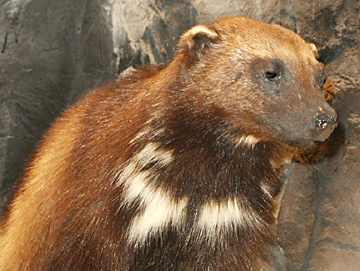 snow-covered
alpine trees. On February 17, 2006, they captured a juvenile female
wolverine in a trap, radio-collared it, and released it back to
the wild. In 2020, I saw a video on TV of a breeding pair being
released, I think in Mt. Rainier National Park (MRNP)... These
are big events, cracking open a door on the most secret and elusive
of the Northwest's furbearers, the animal the Native Americans
called "Trickster Hero." With such big successes under
their belts, next thing you know, the biologists are finally going
to capture and radio-collar an Oregon
Bigfoot!
snow-covered
alpine trees. On February 17, 2006, they captured a juvenile female
wolverine in a trap, radio-collared it, and released it back to
the wild. In 2020, I saw a video on TV of a breeding pair being
released, I think in Mt. Rainier National Park (MRNP)... These
are big events, cracking open a door on the most secret and elusive
of the Northwest's furbearers, the animal the Native Americans
called "Trickster Hero." With such big successes under
their belts, next thing you know, the biologists are finally going
to capture and radio-collar an Oregon
Bigfoot!
Picture immediately above was taken by me recently at the new Cabela's store in Lacey, Washington. The Wolverine specimen resting on their "Wildlife Mountain" was my first "up close" look at a "real" Wolverine.
Sobering Note: During the summer of 2003, the B&B Complex Fire burned up much of the area around Three-Fingered Jack. Hopefully, if there was a resident wolverine population in the Jack area, it survived.
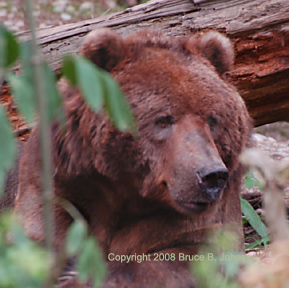 A
related note is about Oregon's Grizzly bears (Urus arctos horribilis).
By all accounts, they have been extinct in Oregon since about
1900. One of the last, and most feared of them, was a huge male
named Old Reelfoot, who roamed the area of the Southern Cascades/Klamath
Basin for decades until he was shot in 1891, some tell me it was
near Pilot Rock, easily visible from I-5 freeway as it crosses
Siskiyou Pass above Ashland.... Two years later his stuffed body
was scaring visitors to the Columbian Exposition in far-away Chicago!
--- Large male specimens of the grizzly bear can run up to 30
miles per hour, weigh over 1,000 pounds and stand eight feet tall
when they rear up to look around-- hopefully not to spy you cowering
beneath!
A
related note is about Oregon's Grizzly bears (Urus arctos horribilis).
By all accounts, they have been extinct in Oregon since about
1900. One of the last, and most feared of them, was a huge male
named Old Reelfoot, who roamed the area of the Southern Cascades/Klamath
Basin for decades until he was shot in 1891, some tell me it was
near Pilot Rock, easily visible from I-5 freeway as it crosses
Siskiyou Pass above Ashland.... Two years later his stuffed body
was scaring visitors to the Columbian Exposition in far-away Chicago!
--- Large male specimens of the grizzly bear can run up to 30
miles per hour, weigh over 1,000 pounds and stand eight feet tall
when they rear up to look around-- hopefully not to spy you cowering
beneath!
* One of Tom Bauman's best-known first ascents took place in 1965, the awesome East Buttress of Mt. Washington, about 30 miles south of Three-FingeredJack. Cick to see East side of Mt. Washington.